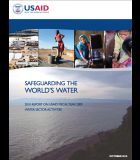In the future, urban areas in the Dominican Republic will face increased risk of severe flooding, sea level rise, higher temperatures, and changes in rainfall patterns. This flooding and uneven rainfall exacerbates wastewater disposal challenges for the 75 percent of the country’s residents who are not connected to regulated wastewater and sewage systems. Large-scale treatment facilities are not feasible given the lack of available land and localization of major settlements, so the Climate Risk Reduction Project “thought small.”
Small-scale constructed wetlands are designed to serve three to five households. Pipes from each kitchen sink flow into a grease trap to remove system-clogging food wastes, and from there into an underground anaerobic tank, which also captures wastewater from bathrooms and toilets. Solids settle to the bottom of the tank while bacteria start to break down pollutants. Liquids then flow into a small wetland, where specialized plants further break down pollutants and layers of sand and gravel act as a mechanical filter. The final treated water is then allowed to enter the water table through a last series of sand, gravel, and rock layers. By that time, 75 to 80 percent of contaminants have been removed.
The cost of a five-household system is around $2,500, or $500 per household, and families often divide the responsibility for hosting the physical infrastructure. For people like Carola Piña, who now has a compact wetland adjacent to her home, the most important thing is that she now has a healthier environment for herself and her two sons. “Now we can breathe!” she exclaims.
Related



